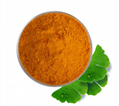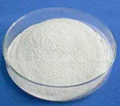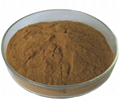| Model: | 8002-43-5 |
|---|---|
| Brand: | Changsha Staherb |
| Origin: | - |
| Category: | Chemicals / Organic Chemical Materials / Pharmaceutical Chemicals |
| Label: | - |
| Price: |
-
|
| Min. Order: | - |
Product Description
Soy lecithin (Lecithin High Potency), also known as soybean lecithin, is a by-product in the process of refining soybean oil, which is obtained by solvent extraction and centrifugation, followed by alcohol washing. The granular soybean lecithin on the market is the phospholipid precipitated by soybean oil during the degumming process, and then processed and dried. Pure soybean lecithin is a brownish-yellow waxy solid, which is easy to absorb water and turn into a brownish-black gelatinous substance, which is easily oxidized, and gradually changes from brownish yellow to brownish black; soybean lecithin contains lecithin, cephalin, etc. Aging, prevention of cardiovascular and cerebrovascular diseases, etc. Soy lecithin can enhance the ability of cells to transmit information, thereby improving brain vitality, and improving the self-repairing ability of cell membranes to protect the liver.
Chinese name: Soy Lecithin
Foreign name: Soybean Lecithin
CAS accession number: 8002-43-5
EINECS Accession Number: 232-307-2
source
It comes from a wide range of sources, mainly in the cells of animals and plants, and is the main component of biological cell membranes. In animals, the heart, liver, brain, kidney, bone marrow and eggs are more abundant; in plants, the content of oil crops is relatively high. Concentrated, such as peanut kernel phospholipid content is 0.4 ~ 0.63%.
Soybean lecithin is a basic substance of life. It is not only an important part of the human biofilm, but also a source of choline and fatty acids. It plays a key role in maintaining the physiological activity of the biofilm and the normal metabolism of the body. Known as "vascular scavenger", lecithin is a comprehensive nutritional product that is often supplemented. It is very important for preventing and improving cardiovascular and cerebrovascular diseases, strengthening the brain, preventing fatty liver and cirrhosis, and beautifying the skin. effect.
"Lecithin" is derived from the Greek word "Lekiths", which means "yolk". In 1844, the Frenchman Gohley discovered lecithin (lecithin) from egg yolk, and named it Lecithos in Greek (Lecithin in English). Since then, the mystery of lecithin has been unveiled. Because it is extracted from egg yolk from the beginning, the "lecithin" originally named actually contains the following components: phosphatidylcholine, phosphatidylethanolamine, phosphatidylinositol, etc.
We first clarify a concept: the "lecithin" on the market is a mixture of various phospholipids, not the purified "lecithin". In order to distinguish the two, we call the former "Phospholipid" and the Chinese name is "Phospholipid". "; the latter, called "phosphatidylcholine", Chinese name "lecithin". "Chemical name: "Phosphatidylcholine".
Generally, the products of phospholipids are generally called "lecithin" in business. That is what we often call "lecithin". This is just a historical misunderstanding and cannot be changed for the time being, just like the "rice" on the table is also called "rice" in some places. Commercially, phospholipids are divided into: soybean phospholipids, rapeseed phospholipids, egg yolk phospholipids, etc. Their composition is very different, due to different origins, different varieties, and similar varieties are also very different.
Pure natural lecithin is mainly obtained from beans and soy products, while rapeseed lecithin has a relatively low nutritional value, and is less used in food and feed industries than soybean lecithin. It is produced by a few manufacturers in Europe.
The difference between soy lecithin and egg yolk lecithin:
All kinds of oil plants in nature contain phospholipids, but their content is not the same. Among several common oil seeds, soybean and cottonseed are the most common, followed by rapeseed. Soybean is the main product that can be industrialized, so the term "soybean lecithin" or "soybean lecithin" is given.
The general composition of soybean lecithin is: phosphatidylcholine PC (lecithin) 25-32%, phosphatidylethanolamine PE (cephalin) 15-22%, phosphatidylinositol PI (inositol phospholipid) about 15%, phosphatidyl Glycerol PG (sphingomyelin) is about 16%, phosphatidic acid PA is about 4%, and other phospholipids are about 8%.
The main difference between egg yolk phospholipid and soybean phospholipid is: phosphatidylcholine is up to 70%, and phosphatidylinositol is only 0.6%. Does not contain: phosphatidic acid, phosphatidylserine, N-acylphosphatidylethanolamine, phosphatidylglycerol.
Physical and chemical properties
Pure products such as lecithin and cephalin are white waxy solids that can crystallize at low temperatures. Because the phospholipid molecule contains a large amount of unsaturated fatty acids, it is easily oxidized by oxygen in the air. After being placed in the air for a period of time, a polymer of peroxide is formed. The color of the phospholipid changes from white to yellow-brown, and becomes brown-black over time. .
The color of soybean lecithin mainly comes from two parts: one part is brought in by soybean raw materials, such as carotenoids, chlorophyll, etc.; the other part is the brown substance generated during processing. The amine group in the browning reaction may be the phospholipid choline amine in the phospholipid, and the free saccharide and the bound carbohydrate in the phospholipid may provide the aldehyde group required for the browning reaction. Aldehyde groups formed during oxidation of unsaturated fatty acids in phospholipids may also be responsible for the formation of aldoamine condensation reactions. The brown substance in phospholipids has the characteristics of many aldol-amine condensation products in foods. Study on the degree of oxidation of lecithin: The unsaturated bond in the lecithin molecule is easily combined with oxygen to form a diene bond and oxidized, and the color changes from white to yellow or brown. After lecithin is oxidized, the encapsulation rate of the prepared liposomes will be low, the leakage rate will increase, and it has hemolytic toxicity, so the degree of oxidation should be controlled. The dilute structure formed after lecithin oxidation absorbs at 233 nm.
Extraction process
Lecithin is usually extracted from soybean by solvent extraction followed by centrifugation followed by alcohol washing.
effect
Soy lecithin is an essential substance extracted from soybeans. It is also one of the lipid components needed by the human body, and is mainly used in industry as an emulsifier, a moisturizing agent, and a thickening agent. At the same time, there are nutritional supplements. Most importantly, there are other physiological regulating effects. And the main effect depends on phosphatidylcholine, that is to say, the core of this part is the real lecithin part.
1. Delay aging
There are 60 trillion cells that make up the human body. 500,000 will die in 1 second, and 500,000 will be regenerated at the same time. As we age, more cells die and fewer cells regenerate. When the number of cell death is greater than the number of regeneration, a person begins to age. The metabolic process of cells is regulated by the cell membrane. The health of the cell membrane is directly related to the cell's self-repair ability, information transmission ability, ability to resist external aggression, cell activity and regeneration ability. The cell membrane is mainly composed of lecithin. Supplementing lecithin to the human body means that the damaged cell membrane can be repaired, the function of the cell membrane can be improved, the cell membrane can be softened and rejuvenated, and the cell activity can be increased. Through the intake of lecithin, the body's metabolic capacity, self-healing capacity and the regeneration capacity of antibody tissues can be improved, the vitality of the body can be enhanced, and the aging of the body can be fundamentally delayed.
2. Vascular scavenger, prevention of cardiovascular and cerebrovascular diseases
Lecithin can emulsify and decompose fat, and can emulsify cholesterol and fat attached to the blood vessel wall into microparticles, which are dissolved in the blood and transported back to the liver for metabolism. It can soften blood vessels, improve serum lipids, remove peroxides, reduce the content of cholesterol and fat in blood, thereby reduce blood viscosity, improve blood circulation, and reduce the retention time of fat in blood vessels. Furthermore, the nutrient-rich, oxygen-rich blood flows unimpeded to the brain, heart and other organs. The Department of Food and Nutrition of Keio University School of Medicine has conducted clinical experiments and concluded that taking lecithin can effectively reduce excessive blood lipids and cholesterol, thereby preventing coronary heart disease, hypertension, myocardial infarction, cerebral thrombosis, and cerebral hemorrhage. , arteriosclerosis and other diseases.
3. Strengthen the brain and improve intelligence, prevent senile dementia
Lecithin can provide sufficient nourishment for brain nerve cells, speed up the transmission of information between the brain nerves, thereby improving brain vitality, eliminating brain fatigue, making brain thinking agile, and improving learning and work efficiency. Lecithin can maintain the normal function of brain nerve cells while repairing damaged brain cells and opening up the obstacles between the brain and blood circulation, and enhance the function of the brain nervous system, thereby achieving the effect of preventing senile dementia.
4. The protector of the liver
Heavy drinking or excess nutrition can increase the burden on liver cells and reduce the liver's ability to synthesize phospholipids. When there is insufficient phospholipid choline in the human body, it will lead to a large amount of fat accumulation in the liver, forming fatty liver, destroying liver cells, reducing liver function, causing liver cirrhosis and even liver cancer. It has been scientifically proven that lecithin supplementation can enhance the metabolism of liver cells, promote fat degradation, protect the liver, and prevent the occurrence of fatty liver and other diseases.
5. Nutritional products for diabetics
Lecithin can enhance the function of the pancreas, repair the cells of the pancreas, make it secrete sufficient insulin, lower blood sugar, and effectively transport the glucose in the blood to the cells, thereby alleviating the condition of diabetes.
6. The main components of biofilms
essential material for the human body
Lecithin can promote mental conduction, improve brain vitality, and because of its good emulsifying properties, it can effectively prevent cholesterol from precipitating on the blood vessel wall and remove part of the sediment, thereby reducing serum cholesterol, reducing blood viscosity, promoting blood circulation, and preventing heart disease. The role of vascular disease. Therefore, regular consumption of products containing soybean soft lecithin can effectively regulate blood lipids and cholesterol, improve brain function, improve memory, and prevent the occurrence of various diseases.
people suitble
1. The "Three Highs" people want to prevent and cure. Cardiovascular disease.
2. Those who want to improve memory and prevent Alzheimer's disease.
3. Excessive drinking or liver dysfunction.
4. Patients with gallstones.
5. Diabetic patients.
6. Rough skin, chloasma and age spots.
Company Introduction
Address: Room 202, Building B8, Huanchuang Enterprise Square, Lugu Street, Yuelu District, Changsha City, Hunan Province
Website: http://www.staherb.cn/
Business scope: Biotechnology, research and development of plant extracts (can be used in the field of pharmaceutical and health products, cosmetics, feed additives and biological pesticide production and development)
Main products: Eucommia extract - chlorogenic acid (5%-98%), ursolic acid (25%-98%), corosolic acid (1%-98%), bitter amygdalin (50%-98%), epimedoside (10%-98%) and other standardized high-purity plant extracts.
If you wanna know more about us, please feel free to contact me at:
Whatsapp: +86 13548561509
Email: staherb18@staherb.cn
or you can send me online message if it's convenient for you.
We look forward to cooperating with you!
Product

Certificate of analysis:
|
Item |
Specification |
Result |
|
Appearance |
Light yellow powder |
Complies |
|
Odor |
Characteristic |
Complies |
|
Assay |
40% |
40.11% |
|
Sieve analysis |
100% pass 80 mesh |
Complies |
|
Loss on Drying |
≤5.0% |
3.12% |
|
Residue on Ignition |
≤5.0% |
2.09% |
|
Heavy Metal |
<10ppm |
Complies |
|
As |
<0.5ppm |
Complies |
|
Pb |
<0.5ppm |
Complies |
|
Cd |
<0.5ppm |
Complies |
|
Residual Solvents |
<100ppm |
Complies |
|
Residual Pesticide |
Negative |
Complies |
|
Microbiology |
|
|
|
Total Plate Count |
<1000cfu/g |
Complies |
|
Yeast & Mold |
<100cfu/g |
Complies |
|
E.Coli |
Negative |
Complies |
|
Salmonella |
Negative |
Complies |
Soybean Extract Isoflavones
What is Soybean Extract Isoflavones?
Latin Name: Glycine max (L.) Merrill [Fam. Fabaceae]
Part Used: Bean
Soy isoflavones are phytochemical constituents of soybeans. The major isoflavones in soy are genistein and daidzein.
Member Information
| Changsha Staherb Natural Ingredients Co., Ltd., | |
|---|---|
| Country/Region: | Hu Nan - China |
| Business Nature: | Manufacturer |
| Phone: | 18975842720 |
| Contact: | Yoland (sales) |
| Last Online: | 15 Nov, 2024 |










